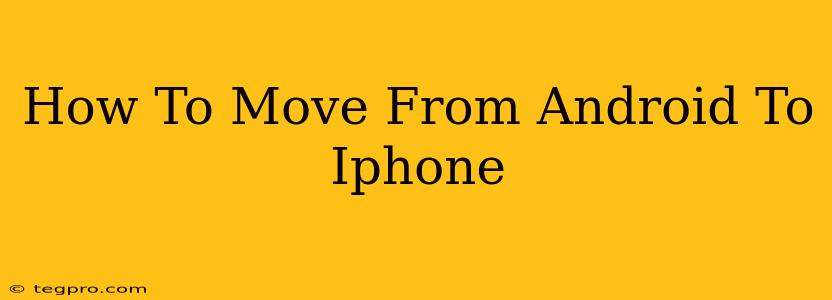Switching from Android to iPhone can seem daunting, but with the right approach, it's a surprisingly straightforward process. This guide will walk you through every step, ensuring a seamless transition and minimizing any potential headaches. We'll cover data transfer, app migration, and essential tips to make your iPhone experience enjoyable from day one.
Preparing for the Switch: Essential Steps
Before you dive into the transfer process, take these preliminary steps to ensure a smooth transition:
1. Back Up Your Android Data:
This is crucial. You don't want to lose precious photos, contacts, messages, or apps. Back up your Android device using your Google account or a third-party backup solution. This will create a complete snapshot of your data.
2. Charge Both Devices:
Ensure both your Android phone and your new iPhone are sufficiently charged. The data transfer process can take some time, and you don't want either device to run out of battery during the transfer.
3. Familiarize Yourself with iOS:
While many functions are similar, iOS and Android have different interfaces and functionalities. Spending some time familiarizing yourself with iOS basics will help you navigate your new iPhone more easily. Watch some introductory videos or read tutorials before you start the transfer.
Transferring Your Data: The Quickest Way
Apple's Quick Start feature makes transferring data from Android to iPhone incredibly easy. Here's how it works:
- Turn on your new iPhone: Follow the on-screen instructions until you reach the screen that says "Apps & Data".
- Position your Android device nearby: Ensure Bluetooth and Wi-Fi are enabled on both devices.
- Select "Move Data from Android": Your iPhone will automatically detect your Android phone and prompt you to begin the transfer.
- Enter your Google account details: This will allow your iPhone to access your contacts, calendar, photos, and other data stored in your Google account.
- Select the data you want to transfer: Choose which data you'd like to move – you can select everything or just specific items.
- Follow the on-screen instructions: The transfer process will take time, depending on the amount of data being transferred. Keep both devices close together and connected to power.
Transferring Data Manually: An Alternative Approach
If Quick Start doesn't work for you, or if you prefer more control over the transfer process, you can transfer data manually. This involves transferring data individually:
- Contacts: Export your contacts from your Android device and import them into your iPhone's contacts app (via a .vcf file).
- Photos and Videos: Use Google Photos or another cloud storage service to sync your photos and videos to your iPhone.
- Messages: Unfortunately, there isn't a direct transfer method for messages. Consider a third-party app (though note that the quality of these varies).
- Apps: Download the apps you use most from the App Store.
Adapting to iOS: Tips for a Smooth Transition
After the transfer, you'll likely need some time to adjust to iOS. Here are some tips:
- Explore the settings: iOS settings are extensive. Take the time to customize your device to your preferences.
- Learn the gestures: iOS relies heavily on gestures for navigation. Mastering these will make using your iPhone much more efficient.
- Utilize Siri: Siri is a powerful tool that can help you perform a variety of tasks.
- Take advantage of Apple's support resources: Apple provides numerous resources to help you learn iOS.
Conclusion: Embrace Your New iPhone!
Moving from Android to iPhone might initially feel like a big leap, but with careful planning and the right approach, it can be a surprisingly smooth experience. By following these steps and taking advantage of the resources available, you can quickly adapt to iOS and enjoy all the benefits of your new iPhone. Remember to be patient and enjoy exploring your new device!

